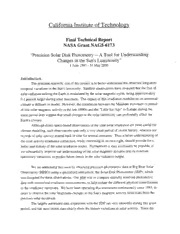
NASA Technical Reports Server (NTRS) 20010043989: Precision Solar Disk Photometry - A Tool for Understanding Changes in the Sun's Luminosity PDF
Preview NASA Technical Reports Server (NTRS) 20010043989: Precision Solar Disk Photometry - A Tool for Understanding Changes in the Sun's Luminosity
California Institute of Technology Final Technical Report NASA Grant NAG5-6173 "Precision Solar Disk Photometry -- A Tool for Understanding Changes in the Sun's Luminosity" 1June 1997 - 31 May 2000 Introduction. The principal scientific aim of this project is to better understand the observed long-term temporal variations in the Sun's luminosity. Satellite observations have revealed that the flux of solar radiation striking the Earth is modulated by the solar magnetic cycle, being approximately 0.1 percent larger during solar maximum. The impact of this irradiance modulation on terrestrial climate is difficult to model. However, the correlation between the Maunder minimum (a period of low solar magnetic activity in the late 1600s) and the "Little Ice Age" in Europe during the same period does suggest that small changes in the solar luminosity can profoundly affect the Earth's climate. Although direct space-based observations of the total solar irradiance are most useful for climate modeling, such observations span only a very short period of recent history, whereas our records of solar activity extend back in time for several centuries. Thus a better understanding of the solar activity-irradiance connection, while interesting in its own right, should provide for a better past history of the solar irradiance output. Furthermore it may eventually be possible, if we substantially improve our understanding of the solar magnetic dynamo and its resultant luminosity variations, to predict future trends in the solar radiative output. We are addressing this issue by obtaining precision photometric data at Big Bear Solar Observatory (BBSO) using a specialized instrument, the Solar Disk Photometer (SDP), which was designed for these observations. Our plan was to compare spatially resolved photometric data with unresolved irradiance measurements, to help isolate the different physical contributions to the irradiance variations. We have been operating this instrument continuously since 1993, in order to observe the solar brightness changes as the Sun's magnetic activity level rises from the previous solar minimum. The largely automated data acquisition with the SDP ran very smoothly during this grant period, and our most recent data clearly show the known variations in solar activity. Since the instrumentisquiteold(atleastincomputeryears),werecentlyupgradedthedataanalysis softwareconsiderably.Thedataarecurrentlywrittenon9-track-tapesw, hicharebecomingmore andmoreobsoletewithtime.ThesetapesaresubsequentlyreadusinganoldVAX workstation, processedsomewhata,ndthedatathentransferredtoCDsforfurtheranalysis.Thisallowsthe useofhigh-levelprogramminglanguagess,uchasMATLAB, forfurtheranalysis.Wenowhave acompletesetofCDsspanningtheperiod1993-1999.Theinstrumentwasalsooperatedduring 2000,butthedatahavenotyetbeenprocessed. Data Analysis andInterpretation. Oneofthemostimportantareasweareinvestigatingwiththisdatasetisthenatureofthe "diffuse"componenot fthesolarirradiancevariations,andmostofourrecentdataanalysiseffort hasbeenaimedatthisquestion.It isknownthatsunspotsreducethesolarirradiance,witha largesunspotgroupproducingatemporarydecreaseof upto0.3percent.Averagedovertime theirradiancereductionfromsunspotsaloneaveragestoroughly0.1percentbetweensolar minimumandmaximum.Thisiscounteredbylarge-scalesolarfaculae,whichincreasethe averageirradiance.Thefacularcontributionismoredifficult tomodelaccurately,butaveraged overtimefaculaeproduceanirradianceincreaseofroughly0.1percentoverthesolarcycle, essentiallybalancingthesunspoctontribution.Sincetheobservedsolar-cycleirradiance variationisabout0.1percent,sunspotsandfaculaealonedonotseemtoexplainall the observationsT. heremainingvariationsappeartobemorediffuseinnature,andarethusdifficult topickoutfromordinarysolarimagingdata. Activenetworkcomponentsmaybesufficienttoexplainthediffuseirradiance componentb,utlarge-scaletemperaturevariationsintheSun'sactivelatitudeshavealsobeen proposed(forexampleseeKuhnandStein,ApJ463,L117(1996)).Wecandistinguishbetween thesetwomodelsusingSDPdatabyobservingthespatialdependenceofthebrightness variations.Brightnessvariationsfrommagneticflux tubes,andthusfromsolarfaculaeand activenetworkregions,showafacularcontrastfunctionthatdependsstronglyonposition relativetothesolarlimb. Rawtemperaturevariationswouldshownosuchlimbsignature. Inarecentpublication(Tayloretal.,SolarPhys.178,1(1998))wesuggestedthatthe magneticnetworkhypothesisfit theSDPdatabetterthanasimplethermalmodel,sincethe brightnessvariationsshowedalimb dependencceonsistentwiththemagneticmodel.However thiswasbasedentirelyondatatakennearsolarminimum,sotheresultcouldnotbevery conclusive.Wenowhavedatathrough1999analyzed,andthefacular-likelimb dependencien thephotometricdatapersists.Thusit appearsmoreandmorethattheluminosityvariations arisingfromactivemagneticnetworkelementsareresponsibleforthediffusecomponenot fthe solarirradiancevariations. Quantifyingtheseconclusionsfurtherhasprovenmostproblematic,however.Libbrecht wasjoinedbyMartinWoodardfromBBSOinanalyzingtheSDPdata,andwefoundanumber ofpuzzlinginconsistenciesinthedata.Wefirstnoticedthatthebrightnessvariationsrecorded withtheSDPareapproximatelyafactoroftwolarger(nearthelimb)thanouroldMt. Wilson limb photometerdata(seeKuhn,Libbrecht,andDicke,Science242,908(1988)),after compensatinfgor solaractivityvariations.Ontheotherhand,ourfirst SDPdatafrom 1991were roughlyconsistentwiththeMt.Wilsondata.Wenaturallysuspectedasoftwarebug,buthave beenunabletofindanythinginanyofthedatasets.Becauseoftheseproblemswehavenotbeen abletocomeupwithanirradiancemodelthatreconcilesthe(resolved)ground-baseddatawith thesatelliteirradiancedata.Thuswearestill shortofourprimarygoalofmakinganaccurate quantitative comparison between the SDP data and solar irradiance data. We are currently analyzing the signal from laminar refraction (in the Earth's atmosphere) in the SDP data, to use that as a calibration signal. Relating these data to recent helioseismic results is also being pursued, along with Phil Goode at BBSO.
